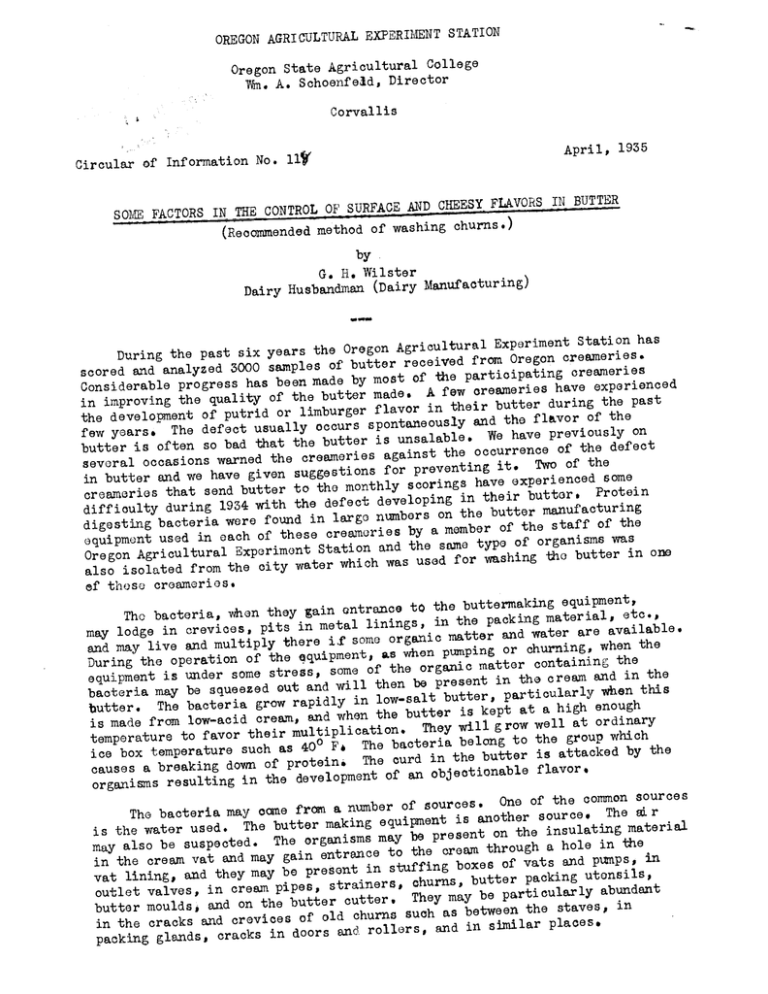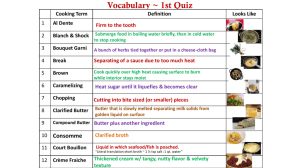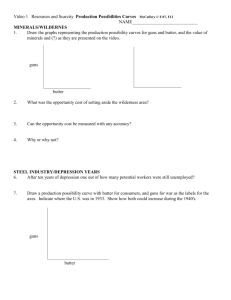State AND CIESY FLVORS IN BUTTER
advertisement

OREGON AGRICULTURAL EXPERIMENT STATION Oregon State Agricultural College n. A. SohoenfeId, Director Corvallis April, 1935 Circular of Information No. 11' FLVORS IN BUTTER IE CONTROL OF SURFACE AND CIESY SOME FACTORS IN (Recommended method of washing churns.) by G. H, Wilater Dairy Husbaridman (Dairy Manufacturing) Agricultural Experiment Station has During the past six years the Oregon received from Oregon creameries. scored and analyzed 3000 samples of butter of the participating creameries Considerable progress has been made by most made. A few creameries have experionoed past in improving the quality of the butter flavor in their butter during the putrid or limburger the development of spontaneously and the fl.vor of the few years. The defect usually occurs unsalable. We have previously on butter is often so bad that the butter isagainst the occurrence of the defect several occasions warned the creameries for preventing it. Two of the in butter and we have given suggestions sooringa have experienced some creameries that send butter to the monthly developing in their butter. Protein difficulty during 1934 with the defect numbers on the butter manufacturing digesting bacteria were found in largo by a member of the staff of the equipment used in each of these creameries the same type of organisms was Oregon Agricultural Experiment Station and used for washing the butter in ox also isolated from the city water which was ef these creameries, to the buttermaking equipment, The bacteria, when they gain entrance material, etc., metal linings, in the packing may lodge in crevices, pits in water are available. organic matter and churning, when the arid may live arid multiply there i! sonic when pumping or During the operation of the equipment, as containing the the organic matter in the equipment is under some stress, some of the cream and be present in when this bacteria may be squeezed out and will then rapidly in low-salt butter, particularly The bacteria grow high enough butter. when the butter is kept at a is made from low-acid cream, and They will grow well at ordinary temperature to favor their multiplication. which 400 F, The bacteria belong to the group by the ice box temperature such as The curd in the butter is attacked causes a breaking down of protein. of an objectionable flavor. organisms resulting in the development One of the common sources of sources. The air The bacteria may come from a number equipment is another source. The butter making material is the water used. be present on the insulating The organisms may the may also be suspected. entrance to the cream through a hole in in in the cream vat and may gain in stuffing boxes of vats and ptnps, they may be present vat lining, and churns, butter packing utensils, outlet valves, in cream pipes, strainers, They may be particularly abundant in butter moulds, and on the butter cutter, churns such as between the staves, in the cracks and crevices of old rollers, and in similar places. packing glands, cracks in doors and 2. Different methods for cleaning and sterilizing churns are used by the creameries, but the following method has been used by the Oregon Agricultural Exp. Station for the past several years and has been found effective in eliminating bacteria, yeasts, and molds from the churns used in the College dairy products laboratory. We can, therefore, recommend it to the buttermakers in the It has been possible to keep the churns in a first-class condition state. during this period. The wood is hard and is free from splinters. It is brigjt in color and has a desirable odor. No difficulty has been experienced with butter sticking to the wood. Directions for Cleaning Churns 1200 F., 1. Add about 50 gallons warm water, temperature not exceeding This removes remnants of to the churn, revolve for a few minutes and drain. curdy butter. Water at a temperature higher than this may hrdon any material which is present. 2. Add 50 to 75 gallons of hot water, temperature above 200°F. (usa the thermometer to determine), to the churn, and to this a4d 3 gallons of a solution containing 2 pounds hydrated lime and 2 pounds of washing soda. The gritty material which settles to the bottom should be excluded. Revolve the churn in high gear for 15 minutes, drain and rinse out any remaining limo particles with water from a hose. 3. Place the doors on the churn and wash the exterior of the churn using soap and water. Rinse with hot water. 0 4. Add 50 to 75 gallons hot water to the churn, tempGrature above 200 F., and revolve in high gear for 15 minutes. Drain through doors and leave to drain for 5 minutes. Then, turn churn so that door openings face upward, arid open the buttermilk gate. 5. Inspect the churn after one-half hour to see that it is clean and openings when the dry inside. Rust-proof screens may be placed in the door churn is not in use. 6. Before using the churn in the morning rinse it with 25 gallons hot water, followed by rinsing with 50 gallons cold water. If hot water is not available in the morning, a chlorine sterilizing solution may be used. Note; Do not heat the water in the churn by using a steam hose introduced If the into the churn. This causes vibration which may damage the churn. water must be heated inside the churn, a properly installed noiseless water will give water at heater may be used. Modern water arid steam mixers, which any desired temperature are on the market. Even when Live steam hou1d not be used for sterilizing wooden churns. treatment it is introduced carefully so that it does not strike the wood, this have been badly is too severe. Churns which were in a good condition damaged by live steam, such as causing blistering of the paint, driving to the the grease into the wood, and causing the pitch from the wood to come exterior surface.





